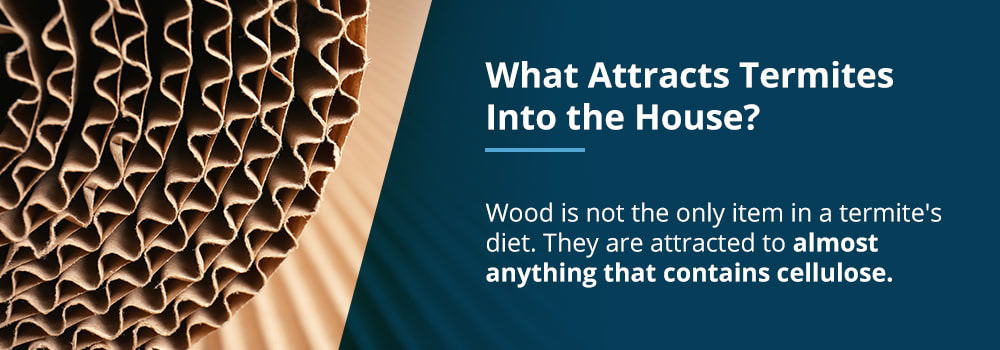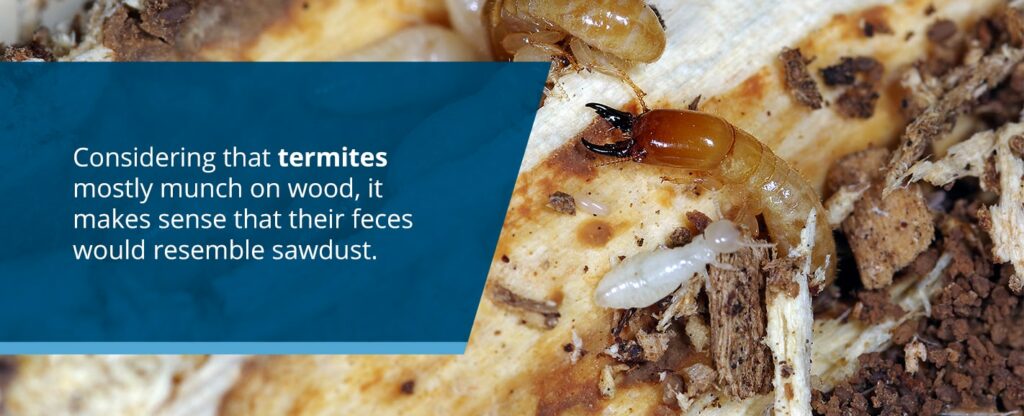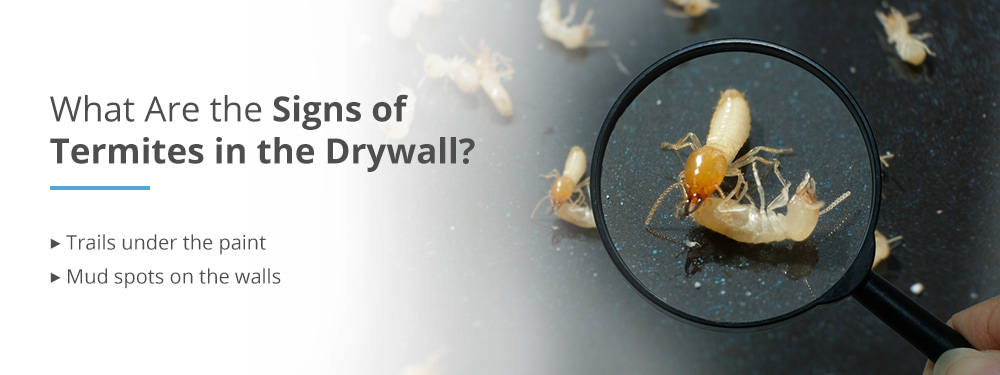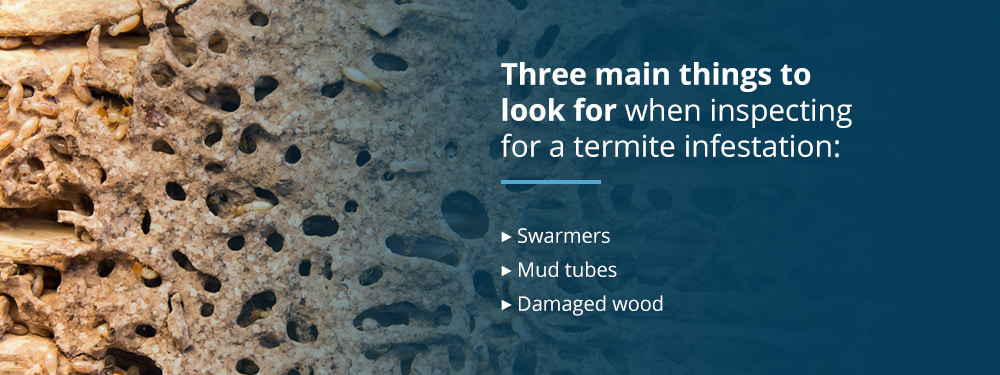Chapter 3: Signs of Termites
Recognizing a termite infestation is not always easy. Termites sneakily go about their work undetected for years. It usually takes the help of a professional to find and confirm the signs of an infestation.

Finding winged termites inside the house is almost always evidence of an infestation because it takes years for a colony to get big enough to produce swarmers. Therefore, homeowners typically discover termites during swarm season, or when they are renovating their home and access its structure.
Even though termites are skilled at staying out of view, there are still ways to find them before an infestation causes too much damage. In this chapter, we’ll show you everything to look for when inspecting your property for termites. If you’re not sure whether or not you have an infestation, it’s recommended to reach out to experts immediately. A termite infestation is not something you want to take lightly.
What Attracts Termites Into the House?
Termites will enter a house in search of food. Termites mostly prefer eating wood, and they even like certain types more than others. For example, even though eastern subterranean termites will eat hardwoods without complaint, they especially enjoy pine and other softwoods. In general, termites prefer moist wood.

Wood is not the only item in a termite’s diet. They are attracted to almost anything that contains cellulose. Cellulose is a type of carbohydrate and gives termites the nutrition they need. Although humans are unable to digest cellulose, termites have special organisms and substances in their guts that allow them to break cellulose down into usable nutrients. Cellulose can be found in household items like:
- Cardboard
- Books
- Paper
Some homeowners may be surprised to find termites infesting a book collection or box of paper. They may also be found in mulch, construction debris and dark, moist, warm areas. They’ll damage a range of materials that they don’t usually eat as they search for food.
Termites constantly look for more grub and will search hundreds of feet from their colony. They’ll tunnel through the first 6 to 12 inches of soil with the hope of finding wood. If rocks or other hard materials keep them from traveling underground, they’ll build mud tubes above the ground. They’ll forage in random directions from the nest site until they find a food source, and then recruit other workers to help them build tunnels to the supply. If a piece of wood has a large amount of moisture and food, they might even establish a nest in the source itself or nearby.
How to Tell If You Have Termites
It can be hard to know you have termites because subterranean termites form tunnels in wood, which may look completely normal from the outside. Plus, they stay in the soil to keep from drying out, which is why they also build mud tubes to forage above ground. There are still clues you can look for to discover an infestation, such as signs of termite damage. Check for the following:
Mud Tubes
Mud tubes are brown, thin tubes that may be found running along the foundation or exterior walls of a building. These tubes, along with termite nests, are made of mud and carton. Carton is a material consisting of chewed wood, feces and soil packed together. These tubes protect termites from predators and dry air as they search for food.
Drop Tubes
Subterranean termites might also create drop tubes. Drop tubes are another type of mud tube that suspends from a wooden structure and extends to the ground. They may be lighter in color than regular mud tubes because they typically contain more wood fiber from the structure.
Swarming Tubes
Termites build swarming tubes when it’s time for swarmers to take flight. These tubes generally extend 4 to 8 inches above the ground and provide an exit tunnel for winged reproductives to leave the colony.
Discarded Wings
Discarded termite wings are typically found near windows or floors. They are equally sized, thin, papery and about 1/4-inch long. Some termites have wings so swarmers can leave their colony, find a mate and start a new colony. Once they find a mate to settle down and start a new colony with, they discard their wings. Therefore, the presence of discarded termite wings indicates a new colony may have begun nearby.
Rippled Paint or Wallpaper
Termite damage may resemble water damage in wallpaper or paint. Sunken trails underneath a wall’s coating can indicate termite activity and moisture related to their presence.
Hollow Wood
Hollow-sounding wood or wooden surfaces that are easily punctured shows that termites have been feasting there. Subterranean termites form galleries in wood by following the grain, while drywood termites create tunnels that cut against the grain. As an example, one person discovered a termite infestation when their vacuum cleaner smashed right through the baseboard.
Termite Droppings
Termite droppings may be a sign of drywood termites and are usually found near wood surfaces. They may look like piles of sawdust or tiny pellets. Pellets are only about 1 to 2 millimeters in length and have a unique six-sided shape. They range in color from cream to black.
Wood Changes
Dark areas or blisters in wood flooring or paneling may be a sign of a subterranean termite infestation. Just like the walls, termite destruction can look similar to water damage on floors.
Winged Termites
Swarmers emerging from the foundation, porches or anywhere indoors are a pretty strong sign of an infestation. Even swarmers appearing near a house may indicate a problem worth investigating. Check stumps and wood sources in the landscape for signs of swarmers. These termites are attracted to light, so you may find them flying around windows, doors, TVs or light fixtures, and they’ll leave a large number of wings behind.
Subterranean termite colonies typically take five years before they produce swarmers. Thus, the sight of winged termites indicates a mature termite colony is somewhere in the vicinity. For this reason, it is a good idea to call a professional pest control service if you find termite swarmers in or around your home or building. It’s possible the termite colony is located off of your property. However, you are looking at a firmly established termite colony infestation if it is on your property.
Cracks Filled With Soil
Soil packed in crevices and cracks may also show an infestation. It’s not uncommon for termites to enter a home through cracks in concrete or any opening they can find near the ground as they search for wood or other cellulose-containing materials.
Tight-Fitting Doors and Hard-to-Open Windows
As termites tunnel through wood, they cause it to warp. If their tunneling occurs in a door frame or window sill, the warped wood could cause problems with opening and closing doors and windows. If you are experiencing tight-fitting doors and hard-to-open windows, you may be dealing with a termite infestation. Of course, other plausible explanations include excess moisture in the wood or temperature fluctuations. Still, it pays to be on the lookout for termites your doors and windows experience unexplained changes.

Signs of Termites in the Drywall
Termite feces, called termite frass, is close in appearance to sawdust when seen from a distance, with a similar color and consistency. Considering that termites mostly munch on wood, it makes sense that their feces would resemble sawdust. Termite frass piles also occur near small holes in the drywall, which lends support to assumptions that they are sawdust piles.
That said, termites create tiny holes in the wall to dump their feces out of. Like humans, they prefer to keep their excrement far from where they sleep, work and play. So if you see a peculiar amount of sawdust or something like it near a tiny hole in the wall, you may have a termite infestation.
Other signs of termites in the drywall include the appearance of faint lines or discoloration. Since drywall is less dense than natural wood, the tunnels subterranean termites create sometimes leave visibly faint lines on the drywall exterior.
If you notice any of the above signs in your home, there’s no need to panic. However, you’ll want to take action as soon as possible and turn to professionals for help. Contact us at Pestech Pest Solutions, and we’ll solve the problem for you. Or, if you’re still not sure what termite damage looks like, we’re here to answer your questions and guide you in the right direction.
What Are the Signs of Termites in the Drywall?
The top two signs of termites in drywall are the appearance of trails under the paint and mud spots on the walls.

Although termites will not eat the gypsum in drywall, they will consume the paper coverings. As much as 10% of a drywall panel may be composed of cellulose — a termite’s favorite ingredient. If termites are working underneath your walls, you might find narrow, sunken trails beneath the paint. You might also find tiny mud spots covering small holes in the walls. These pinholes appear by accident, and termites quickly repair them with mud to prevent exposure to the outside air. If you find mud covering a hole you recently scraped away, you can assume a termite worker patched it up. You might even see a termite investigating a newly uncovered hole. By this point, it’s time to call a pro.
What Do Termites Sound Like?
Soil is an excellent insulator, so it can be challenging to hear termites at work. However, if you have an infestation and listen carefully, you might hear a rustling sound as workers chew their way through the wood. Soldier termites are the loudest of all because they headbang. Headbanging is when soldiers quickly and repeatedly slam their heads against a surface, causing it to vibrate. This sends a message to workers that a threat is nearby. Humans can detect a rattling sound when this occurs, but termites will react to the vibration.
How Long Does It Take for Termites to Destroy a House?
It usually takes several months or years for subterranean termites to cause significant damage in a home, but this also depends on factors such as the weather. For example, in northern regions, termite activity declines in the winter but may continue year-round if the insects find protection from cold temperatures. Regardless, prevention is key to protecting a house from severe termite damage and is the reason why homeowners should take immediate action if they suspect an infestation.
How to Inspect for Termites
Most homeowners are unaware that an infestation exists until they find a visible sign.

There are three main things to look for when inspecting your home for a termite infestation, which are:
- Swarmers
- Mud tubes
- Damaged wood
Any of the above may indicate a termite problem. Pay special attention to wood mulch and any areas where wooden structures in the home contact the ground. Also, make sure to inspect any cracks or openings in your home and look for mud tubes or packed soil. Even though termites cannot eat through a concrete foundation, they can enter through the cracks. Termites can also get in the home through sewage lines and electric conduits, which must also be inspected.
If you notice any signs of termites, make sure to hire a professional to conduct a thorough inspection. A professional examination should be conducted before treating the issue. A professional will make sure you have termites and not another type of pest so they can handle the infestation properly. They’ll also know where to look and can take steps to prevent future infestations.


